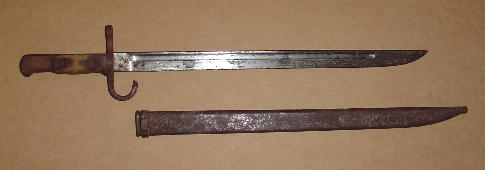For no particular reason I have found myself thinking about sword bayonets recently. Perhaps it was because in a recent re-run of “Wonder Woman” a soldier was wearing one, which struck me as odd since he was an MP in white equipment and you would have expected a baton rather than a bayonet. (for that matter, the episode was set in the 1970s so a sword bayonet would have been an unlikely piece of equipment for any GI!)
My interest in sword bayonets goes back many years. One reason is in the opening passages of the Modesty Blaise adventure “Operation Sabre Tooth” there is a trial by combat and a soldier requests a bayonet to defend himself. Another character reveals he keeps as sword bayonet under the seat of his jeep and enthuses over its merits other a knife. Another source of my interest is the following passage in the Gun Digest Book of Knives, Fourth Edition. Page 106.
“The Yataghan is more of a machete-length short sword with a kukri’s chopping forward curve, but with the point brought back for thrusting. These can have considerable advantages over a machete. The Yataghan was widely used for so-called “Sabre Bayonets” at the time of the War Between the States. The Remington Zouave Rifle carried it, as did many European guns of the period. Perhaps its short sword length and association with the bayonet prevented its other capabilities from being appreciated. At any rate, this splendid weapon didn’t catch on in the West except in bayonet form. It still offers much to the user and should not be overlooked when making your choice. It has the length and reach of the machete in a stiffer blade. It is a powerful forward-curved chopper like a kukri, yet retains a fine thrusting point. Well balanced and lively in the hand it will perform hard work with ease.It is light and easy to carry as well.”
Careful readers will note that it is often uncertain if the author of the above is discussing yataghans in general or specifically yataghan-style bayonets. The poor quality photo in the article seems to suggest a bayonet blade that has been fitted with a new grip (possibly stag antler).
The story of sword bayonets begins with the hanger. Hangers were a short sword that was carried by infantry and other troops. The hanger itself was derived from a civilian tool favoured by outdoorsmen. Hangers, “short hunting swords” or “couteau de chasse” were useful for chopping firewood, clearing brush and butchering game. They were carried by noble and commoner alike. There are exciting accounts of them being used to hunt game and they were a useful defence against both beast and man. Decorated versions might be worn out court to display one’s affection for hunting. They might also be worn in town as a handy defence against robbers, in many cases being more effective and convenient than rapiers or small swords. Understandably the common foot soldier found the hanger to be a useful implement. In addition to the sword bayonet the hanger is probably the ancestor of both the naval cutlass and the machete, and is why you occasionally come across machetes referred to as cutlasses. Sword bayonets were created to produce a bayonet that also served as an infantryman’s hanger. The yataghan configuration blade provided better clearance for the hand when reloading a muzzle-loading weapon. The blade shape is not without other merits so a number of breech loaders also used sabre bayonets.
Despite the claims of the passage quoted above, most sword bayonets I have handled would not be particularly good general survival knives. Most hangers resemble shortened sabres with slightly curved blades. They can fight with both point and edge but their application as brush knives means they have to be effective choppers. Most bayonets, on the other hand, then to have their weight well towards the hilt. Many of the older examples have solid brass hilts. Those that do not still have a considerable weight of metal in the grip designed to facilitate attachment to a rifle or musket. I have a number of wakizashi, barongs, machetes and kurkis of comparable weight and/or length to my sword bayonets. Just handling them makes it clear that for medium to heavy chopping the sword bayonets are inferior.
The sword bayonet may have been intended to replace the soldier’s hanger but it was a poor substitute when it came to use as a general utility tool. As a bayonet if may be argued that they certainly looked impressive and provided a long reach. On the other hand their weight when fitted affected the mean point of impact when shooting. Several nations came to the conclusion that lighter, handier bayonets were more practical.
It is the sword bayonet as a hand weapon that I intend to look into over the next few posts. Sword bayonets, as you might expect, are well suited to thrusting attacks. Their blades are long, narrowish, rigid and often provided with fullers or strengthening ribs. While chopping power is limited the length of the blades can be used to apply a draw cut against thinly protected flesh. We will look into these aspects in later posts.
If you have enjoyed this article or it has been helpful to you please feel free to show your appreciation. Thank you.The Books







